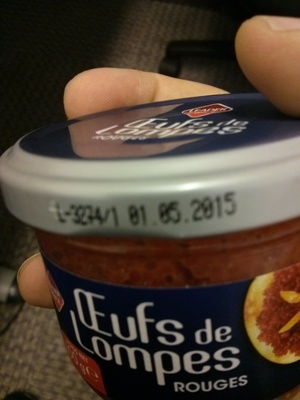Œufs de Lompes Rouges - Leader Price - 100 g
This product page is not complete. You can help to complete it by editing it and adding more data from the photos we have, or by taking more photos using the app for Android or iPhone/iPad. Thank you!
×
Barcode: 3263859430917 (EAN / EAN-13)
Common name: Œufs de lompes salés, colorés et pasteurisés
Quantity: 100 g
Packaging: Metal, Glass, Canned, Fresh, Jar, Lid, fr:Semi-conserve
Brands: Leader Price, DLP (Distribution Leader Price), Groupe Casino
Categories: Seafood, Canned foods, Fish and meat and eggs, Fresh foods, Fish eggs, Semi-preserved foods, Semi-preserved lump roe, fr:Poissons sauvages
Labels, certifications, awards:
Green Dot, fr:Eco-Emballages
Origin of ingredients: Greenland, fr:Atlantique Nord-Est et Atlantique Nord-Ouest, fr:Œufs de lump (Cyclopterus lumpus)
Manufacturing or processing places: Royal Greenland Seafood GmbH - Schleusenstraße 2 - 27472 Cuxhaven, Basse-Saxe, Allemagne
Traceability code: DE NI-10699 EG
Stores: Leader Price
Countries where sold: France
Matching with your preferences
Environment
Packaging
Transportation
Report a problem
Data sources
Product added on by teolemon
Last edit of product page on by packbot.
Product page also edited by anonymousgeek, jacob80, oc84, yuka.Zlo1ZkZvb1lvdXMwa3M4QTNVam93WXRPOXJyeVhYT3dNTU1nSVE9PQ.











